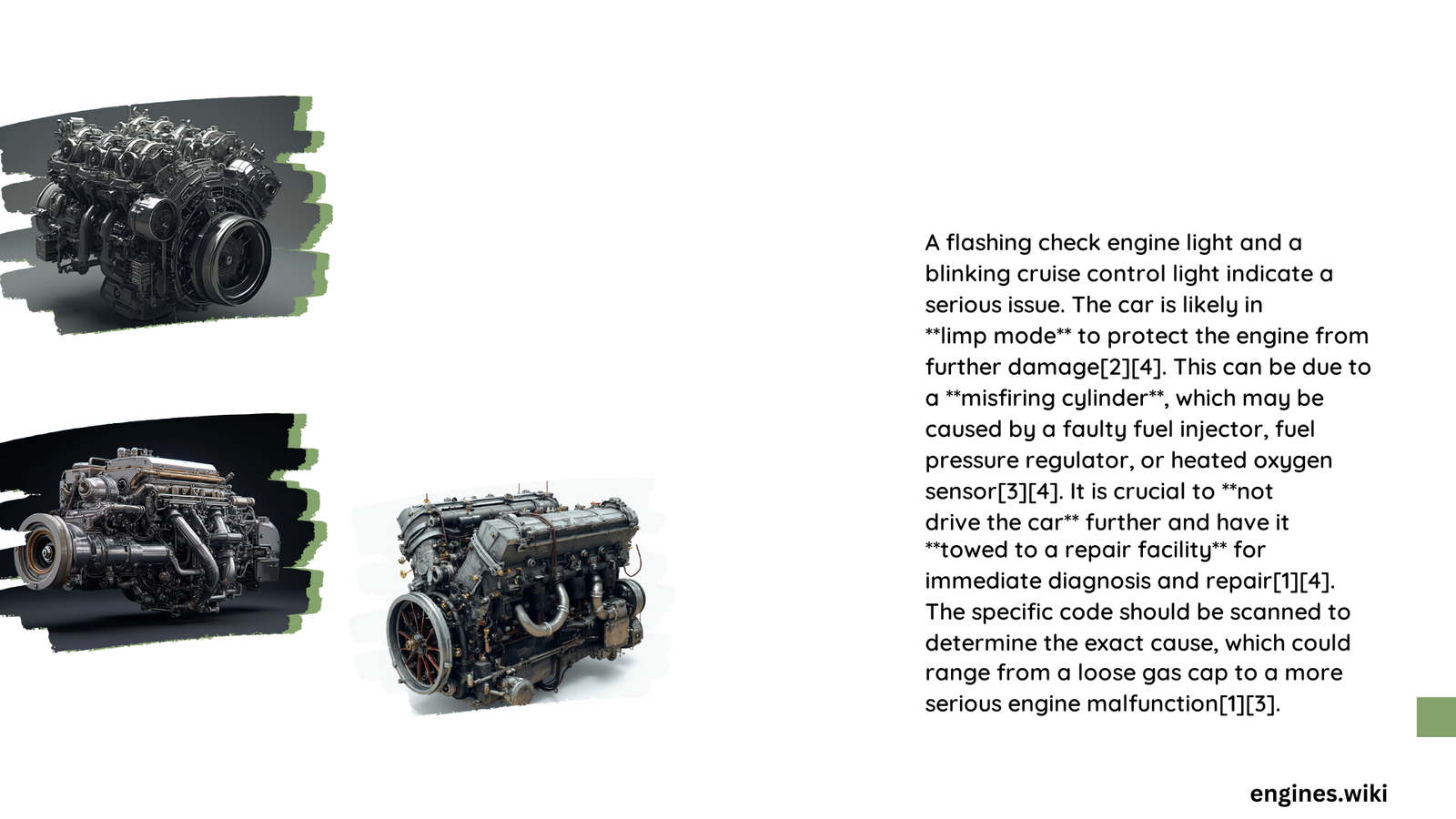A flashing check engine light accompanied by disabled cruise control is a serious warning sign in vehicles. This combination typically indicates critical engine problems, often related to misfires or severe malfunctions. Immediate attention is crucial to prevent potential engine damage. The issue can stem from various sources, including faulty spark plugs, ignition coils, or fuel system problems. Understanding the causes and solutions is essential for maintaining vehicle health and safety.
What Are the Common Causes of a Flashing Check Engine Light and Disabled Cruise Control?
The simultaneous occurrence of a flashing check engine light and disabled cruise control can be attributed to several factors:
- Engine Misfires: This is the most common cause, often resulting from:
- Faulty spark plugs
- Damaged ignition coils
- Clogged fuel injectors
-
Low fuel pressure
-
Sensor Malfunctions: Critical sensors providing inaccurate data can trigger these symptoms:
- Oxygen sensors
- Mass airflow sensors
-
Crankshaft position sensors
-
Electrical System Issues: Problems in the vehicle’s electrical system can cause:
- Voltage fluctuations
- ECU communication errors
-
Intermittent power supply to crucial components
-
Catalytic Converter Problems: A failing catalytic converter can lead to:
- Increased exhaust backpressure
- Engine performance issues
- Triggering of multiple error codes
How Does Engine Misfire Relate to Cruise Control Deactivation?

Engine misfires and cruise control deactivation are closely linked:
-
Safety Mechanism: Modern vehicles automatically disable cruise control when detecting severe engine issues to prevent potential accidents.
-
Performance Inconsistency: Misfires cause irregular engine performance, making it unsafe for cruise control operation.
-
ECU Response: The Engine Control Unit (ECU) disables non-essential functions like cruise control to prioritize engine protection.
-
Sensor Feedback Loop: Misfires can cause erratic sensor readings, leading the ECU to disable cruise control as a precautionary measure.
What Diagnostic Steps Should Be Taken for This Issue?
When faced with a flashing check engine light and disabled cruise control, follow these diagnostic steps:
- OBD-II Scanner Use:
- Connect an OBD-II scanner to retrieve specific error codes
- Look for misfire-related codes (P0300-P0308)
-
Check for sensor-related codes
-
Visual Inspection:
- Examine spark plugs for wear or damage
- Check ignition coils for signs of failure
-
Inspect fuel injectors and fuel lines for leaks or clogs
-
Fuel System Check:
- Measure fuel pressure
- Inspect fuel pump operation
-
Check fuel filter condition
-
Sensor Testing:
- Use a multimeter to test oxygen sensor functionality
- Verify mass airflow sensor readings
-
Check crankshaft position sensor output
-
Electrical System Evaluation:
- Test battery voltage and condition
- Inspect alternator output
- Check for loose or corroded electrical connections
What Are the Potential Repair Solutions and Costs?
Addressing a flashing check engine light and disabled cruise control may involve various repairs:
| Repair Solution | Estimated Cost Range |
|---|---|
| Spark Plug Replacement | $100 – $250 |
| Ignition Coil Replacement | $150 – $400 per coil |
| Fuel Injector Cleaning/Replacement | $200 – $800 |
| Oxygen Sensor Replacement | $150 – $500 |
| Mass Airflow Sensor Replacement | $200 – $400 |
| Catalytic Converter Replacement | $500 – $2,500 |
| ECU Reprogramming | $150 – $300 |
Note: Costs can vary based on vehicle make, model, and location.
How Can This Issue Be Prevented in the Future?
Preventing a flashing check engine light and cruise control issues involves proactive maintenance:
-
Regular Tune-ups: Schedule periodic engine tune-ups to catch potential issues early.
-
Timely Part Replacements: Replace wear items like spark plugs and ignition coils at recommended intervals.
-
Fuel System Maintenance: Use quality fuel and consider periodic fuel system cleaning.
-
Sensor Care: Keep sensors clean and replace them when recommended by the manufacturer.
-
Electrical System Check: Regularly inspect battery, alternator, and wiring for signs of wear or corrosion.
-
Prompt Attention to Warning Signs: Address any engine performance issues or warning lights promptly.
-
Quality Parts: Use OEM or high-quality aftermarket parts for replacements.
By following these preventive measures, you can significantly reduce the likelihood of experiencing a flashing check engine light and disabled cruise control, ensuring better vehicle reliability and performance.
References:
1. Subaru Outback Forum
2. Bob Is The Oil Guy Forum
3. Exeter Subaru
